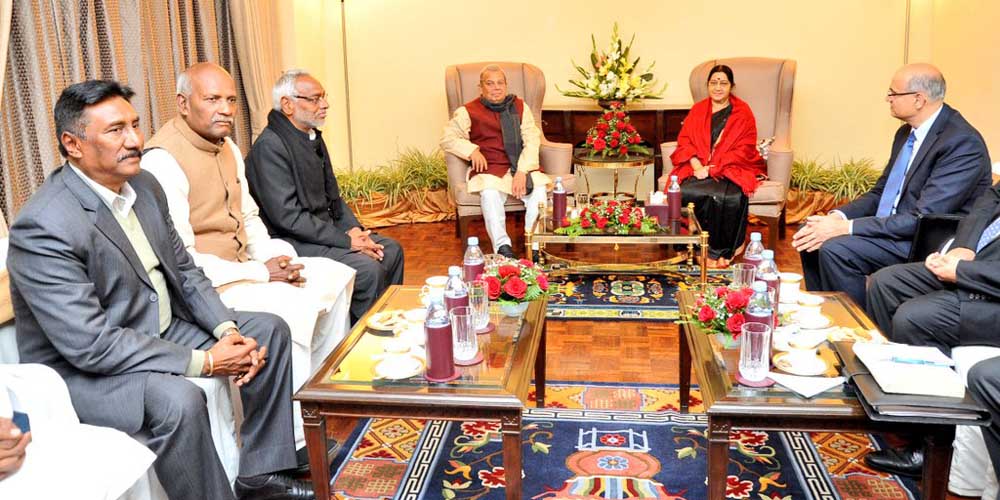
New Delhi is clearly in a mood for ‘course correction’ on Nepal. Having decided to support the border-centric protests of Madhesi parties, which brought Nepal to a standstill for over four months, the new emphasis is once again on directly engaging Kathmandu. The cause of the Madhesi people, if the Indian establishment ever believed in such a thing, has been conveniently sacrificed at the altar of the old geopolitical game that was tilting towards China.
Sino-Nepali ties had gotten a boost following the India-inspired blockade, what with KP Sharma Oli going to China to sign landmark transit and fuel agreements in its wake. China has since cleverly used the rising anti-India sentiment to expand its influence in Nepal. The Chinese stock in Nepal, in fact, has never been higher.
This is why Indian Prime Minister Narendra Modi has of late been keen to cultivate Oli, the prime minister-in-waiting, as reflected in his repeated calls to the CPN-UML chief, and dispatching of his foreign minister, Sushma Swaraj, to Kathmandu on the eve of Oli assuming power. Gradually being forgotten is the animosity that Oli had built for himself in New Delhi as he inched closer to China post-blockade. Only by maintaining friendly relations with Kathmandu, New Delhi has discovered, can a semblance of challenge be mounted to China’s growing clout in Nepal. (Too bad the Madhesis don’t figure in this new calculation.)
What is interesting is that KP Sharma Oli seems as keen to improve the frayed Nepal-India ties. So when Modi called on January 21 to congratulate “the new prime minister of Nepal”, and invited him to visit India on assuming premiership, Oli gladly accepted the invite and said he also wanted to welcome Modi and arrange for his visit to Janakpur and Muktinath. Then, on his message on India’s Republic Day on January 26, Oli once again conveyed his eagerness “to work with your Excellency and your government for the betterment of our two countries.”
Oli’s overtures to India should come as no surprise. After all, not long ago, Oli was reputed as among India’s most trusted in Nepal, one with extensive ties not just with the Indian political parties but also with their bureaucrats and spies. Were it not for the border blockade and the resulting anti-India hysteria, it is inconceivable that Oli would have dared to bite the hand of his old patrons. As former Indian foreign secretary Shivshankar Menon likes to say: Oli’s cozying up to China after the blockade was no different to similar efforts of other power-hungry politicians in the region who, like Oli, are ready to do just about anything to get to power.
But there is a wee problem in this reading. It is true that Oli’s growing proximity to China owes to his desire to cash in on the recent nationalist anti-India fervor. Yet, at the fag-end of his political career, perhaps even his life, Oli also wants to leave behind a sterling legacy: of someone who brought back much-needed balance in Nepal’s relations with India and China.
This is why he is for expediting works on establishing reliable road and rail links between Nepal and China, which is only right. After all, Nepal has time and again been reminded—and how!—of the exorbitant costs of overreliance on India. Any self-respecting leader of post-blockade Nepal would work to create a condition whereby no country, not even the mighty ‘Big Brother’ next door, is in a position to blackmail Nepal.
Oli is thus torn between his desire to appease India (to extend his government-stay) and to further improve Nepali’s relations with China (a populist measure that is nonetheless also in Nepal’s interest). It will not be easy. India seems in a mood to make significant concessions, including revising the 1950 treaty. In return, it will expect Nepal to keep a calibrated distance with China. But there is now a big constituency in Nepal clamoring for closer ties with China and any Nepali leader who ignores this reality will be committing a political hara-kiri.
Oli, the consummate politician that he is, may be among the rare Nepali leaders capable of pulling off this delicate balance, at least for some time. But it will be hard to sustain. Unlike in the past, China today, just like India, is looking for Nepal’s unambiguous commitment to closer cooperation. This is part of its broader South Asian strategy to minimize ‘American influence’, the influence that is often expressed via America’s regional ‘proxy’: India. On the other hand, India fears that unless the rulers in Kathmandu and Thimpu and Dhaka are quickly and firmly brought back into its camp, its strategic space in South Asia will be forever lost to China.
In the lead-up to the 2019 Lok Sabha elections Modi will want to show his ‘Look East’ policy, and his South Asian policy in particular, has been a success. After all, this is a prime minister who started his tenure by inviting all SAARC heads of state to his swearing-in, sending a clear signal of his intent as prime minster.
He will have a tough time tackling a resurgent China in Nepal. Oli, Modi and company may soon discover, has acquired a harder edge, too










